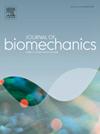The effect of bone relaxation on the simulated pull-off force of a cementless femoral knee implant
IF 2.4
3区 医学
Q3 BIOPHYSICS
引用次数: 0
Abstract
Aseptic loosening is the primary cause of revision in cementless total knee arthroplasty (TKA), emphasizing the importance of strong initial stability for long-term implant success. Pre-clinical evaluations are crucial for understanding implant fixation mechanics and improving implant designs. Finite element (FE) analysis models often use linear elastic bone material models, which do not accurately reflect bone’s mechanical behavior. Incorporating a von Mises yield model to simulate bone’s plastic behavior improved predictions of primary stability but tends to overestimate fixation, potentially due to neglecting bone viscoelasticity. Stress relaxation in bone can affect primary stability by reducing press-fit forces on implants. This study aimed to include bone relaxation into FE models of femoral TKA reconstructions to investigate the impact of bone material models on primary fixation. Simulated pull-off tests were conducted using three material models: elastic, plastic, and plastic-viscoelastic. Six femoral reconstructions, previously used in another study, were included. The average pull-off force decreased (about 79%) from 31 kN with the elastic model to 6.3 kN when bone plasticity was included. Introducing stress relaxation showed a minimal effect, leading to an additional reduction in pull-off force of 0.8%. A significant positive correlation was found between bone mineral density and pull-off force across the three material models. Additionally, elastic strain energy within the femur correlated strongly with pull-off force, suggesting higher strain energy increases pull-off force. This study is the first to integrate plastic and viscoelastic bone behavior in FE simulations, offering insights into cementless implant fixation within context of realistic bone mechanics.
求助全文
约1分钟内获得全文
求助全文
来源期刊

Journal of biomechanics
生物-工程:生物医学
CiteScore
5.10
自引率
4.20%
发文量
345
审稿时长
1 months
期刊介绍:
The Journal of Biomechanics publishes reports of original and substantial findings using the principles of mechanics to explore biological problems. Analytical, as well as experimental papers may be submitted, and the journal accepts original articles, surveys and perspective articles (usually by Editorial invitation only), book reviews and letters to the Editor. The criteria for acceptance of manuscripts include excellence, novelty, significance, clarity, conciseness and interest to the readership.
Papers published in the journal may cover a wide range of topics in biomechanics, including, but not limited to:
-Fundamental Topics - Biomechanics of the musculoskeletal, cardiovascular, and respiratory systems, mechanics of hard and soft tissues, biofluid mechanics, mechanics of prostheses and implant-tissue interfaces, mechanics of cells.
-Cardiovascular and Respiratory Biomechanics - Mechanics of blood-flow, air-flow, mechanics of the soft tissues, flow-tissue or flow-prosthesis interactions.
-Cell Biomechanics - Biomechanic analyses of cells, membranes and sub-cellular structures; the relationship of the mechanical environment to cell and tissue response.
-Dental Biomechanics - Design and analysis of dental tissues and prostheses, mechanics of chewing.
-Functional Tissue Engineering - The role of biomechanical factors in engineered tissue replacements and regenerative medicine.
-Injury Biomechanics - Mechanics of impact and trauma, dynamics of man-machine interaction.
-Molecular Biomechanics - Mechanical analyses of biomolecules.
-Orthopedic Biomechanics - Mechanics of fracture and fracture fixation, mechanics of implants and implant fixation, mechanics of bones and joints, wear of natural and artificial joints.
-Rehabilitation Biomechanics - Analyses of gait, mechanics of prosthetics and orthotics.
-Sports Biomechanics - Mechanical analyses of sports performance.
 求助内容:
求助内容: 应助结果提醒方式:
应助结果提醒方式:


